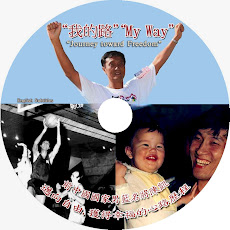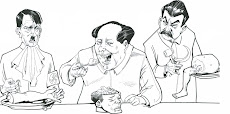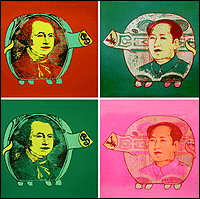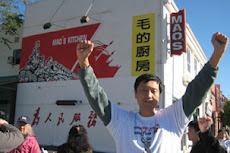 Confucius Institute's Logo
Confucius Institute's Logo Confucius Institutes: Authoritarian Soft Power
孔学院--专制灭灵工具
Some Facts about Confucius Institute and Hanban
关于孔学院的一些必知信息:
http://www.underminingdemocracy.org/china/international
Joshua Kurlantzick & Perry Link
 陈凯博客: www.kaichenblog.blogspot.com
陈凯博客: www.kaichenblog.blogspot.com One of the tools China has used to expand its international influence and promote its model of governance is the fast-growing network of Confucius Institutes.
The institutes, which provide instruction in Chinese language and culture, typically operate as partnerships between Chinese universities and a university in the host country, with the latter supplying a site and other facilities, and the former providing the staff and teaching materials.
The centers are supervised by the Chinese Language Council International (Hanban), which sets their guiding principles, budget, and curriculum.
1. The council is composed of representatives from 12 state ministries and commissions, including the ministries of education, foreign affairs, and culture.
2. The Confucius Institutes initiative describes its purpose as “enhancing intercultural understanding in the world by sponsoring courses of Chinese language and culture, so as to promote a better understanding of the Chinese language and culture among the people of the world.”
However, some observers have raised concerns about the potential effects of Chinese state influence on academic freedom in the host countries. A set of draft guidelines for the institutes suggests that Chinese authorities would require them to comply with political directives on sensitive issues, such as Taiwan’s international status or historical inquiry related to persecuted ethnic and religious minorities: “Overseas Confucius Institutes must abide by the One-China Policy, preserve the independence and unity of the People’s Republic of China, and . . . refrain from participating in any political, religious or ethnic activities in the country where they are located.”
3. The network has expanded rapidly since the first institute opened in Uzbekistan in 2004.
4. There are now more than 295 of the centers in 78 countries, with a total of 500 set to be established before 2010. The existing institutes include more than 20 in Southeast Asia,
5. over 40 in the United States,
6. and more than 70 in Europe.
7. Others have been founded in African countries, including Zimbabwe and South Africa.
8. The project has entailed the deployment of more than 2,000 staff members,
9. and more than 300,000 sets of textbooks and audio materials worth over $26 million.
----------------------------------------------------
http://www.underminingdemocracy.org/china/findings
FINDINGS 我们的调查结论
Joshua Kurlantzick & Perry Link
•The Chinese authorities have forged a multifaceted and increasingly sophisticated set of policies to undermine democratic development. These policies are comprehensive, encompassing the political, legal, social, and media spheres.
•The CCP has deliberately stoked and shaped Chinese nationalism, and many residents now feel pride in the CCP’s model of authoritarian development. The party’s “thoughtwork” to this end has come to include, in addition to censorship, the fashioning of textbooks, television documentaries, museums, and other media that spread seriously distorted versions of Chinese history. In a related effort to guide the public’s thinking, the word democracy has been twisted beyond recognition and stripped of the values that have traditionally defined it.
•While the blunt instruments of media control—harassment, intimidation, and imprisonment— are still used, the Chinese authorities have also developed more nuanced methods to manipulate content and induce self-censorship. These include the commercialization of censorship, through which the authorities effectively outsource censorship tasks to internet-service providers and other private actors. The regime has augmented its domestic media controls with an ambitious, multibillion-dollar plan to upgrade its overseas broadcasts.
•The Chinese government’s exertion of international influence expresses itself in several ways. There is one group of harsh regimes—including those of Sudan, Burma, Uzbekistan, North Korea, and Zimbabwe—whose leaders are seeking only financial assistance and protection from China at the United Nations and other international bodies. Another, more diverse group of developing countries across Asia, Latin America, and Africa are receptive to all elements of Chinese soft power. They are seeking economic, political, and cultural ties to China, and because they are not purely authoritarian states, China’s allure is allowed to extend to the public. These relationships can be more substantial than a simple alliance with an autocrat or ruling clique.
•The United States and other democracies need to be more aware of the workings of the CCP’s soft-power initiatives around the world, and particularly the ways in which they protect and promote authoritarian rule. Democratic states must ensure that diplomats heading to China, its neighbors, and other parts of the developing world are equipped to understand the goals and tactics of such soft-power programs. Where the Chinese enterprises promote authoritarianism, democratic envoys must have effective means of countering them. This work should not simply focus on China and Chinese projects, it should also remind the host countries’ officials and civil society of the virtues of democracy, the pitfalls of an authoritarian development model, and the dangers that would arise if such a model were actually “successful.”

































No comments:
Post a Comment